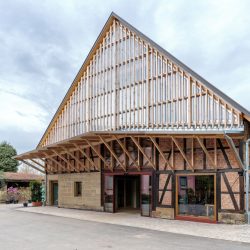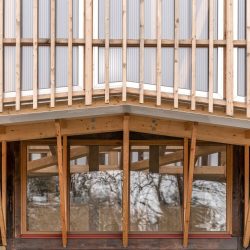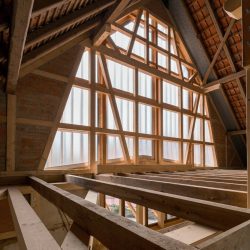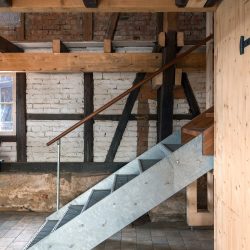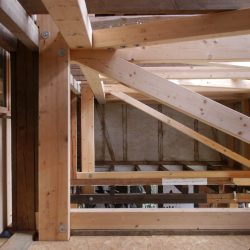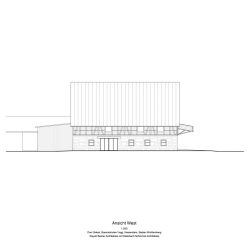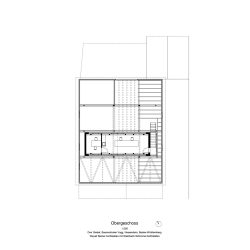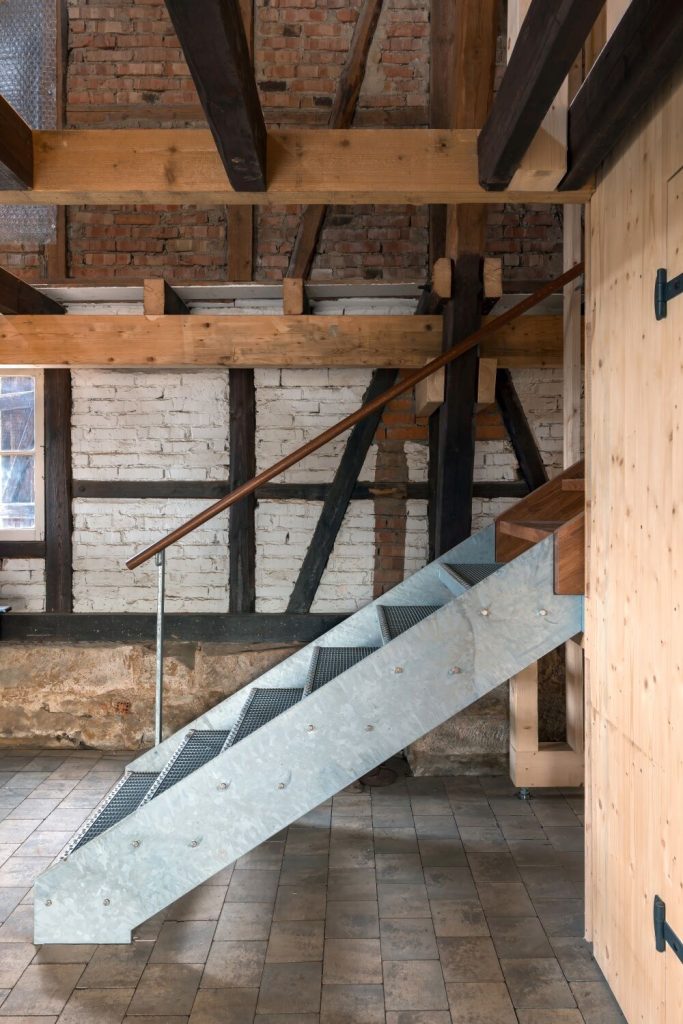
The conversion of an existing barn creates new commercial spaces for a tree nursery in Neuenstein, Germany. The sensitive integration of new functions into an existing structure reduces the consumption of resources and energy. The building takes on a new role within its context, continues the history of the family business and strengthens the identity of the down-to-earth horticultural company.
Three gables
How can we uncover the barn’s inherent charm, with its natural stone walls, sandstone floors, and distinctive timber construction? A ‘house within a house’ concept, utilises the existing barn as a shelter from the elements. The impressive interior is cleared, presenting itself as a large spatial volume. The new uses are cleverly woven into the existing framework. Two new additions provide all functions needed: a bridge structure housing a cash desk, plant room and office space, and a curtain wall façade with a canopy. Reactivating existing openings integrates the interior into the daily process of the company’s workflow for visitors and staff.
Due to its construction on existing foundations post-fire, the barn’s shape is asymmetrical. The inserted structure mirrors the barn’s roof, fostering a dialogue among the three gables: the barn itself, the canopy and the insertion.
Spatial Sequence
As one moves through the barn, narrow and wide spaces and light and shadow overlap, creating different spatial qualities. In the entrance facade fields in the timber framework are opened to allow daylight into the interior. During the day, the influx of light enhances the perception of space as the entire roof space is illuminated. At dusk, the inner structure comes to the forefront and becomes a striking luminous element for passersby.
This is why no additional openings are required and the characteristic large roof covering can be preserved.
Transforming a 1940 Barn with minimal Intervention
The primary challenge of this project is to transform the 1940 barn into a multifunctional space while preserving its original structure and highlighting its historical qualities. The project also aims to achieve maximum impact within a small budget through the clever use of light, existing structures, and the chosen house-in-house typology.
Innovative Elements
1. Minimal Intervention: The design maintains the existing building structure, showcasing its qualities while transforming it for new uses. By clearing the impressive interior, the barn’s spatial volume is revealed.
2. House Within a House: This concept uses the barn’s structure for weather protection, allowing the new uses to be woven into the existing framework. This approach minimizes changes to the structure while maximizing functionality and preserving historical integrity.
3. Clever Use of Light: Natural light is harnessed to enhance spatial perception. Openings in the timber framework allow daylight to flood the interior, illuminating the entire roof space during the day. At dusk, the inner structure becomes a striking luminous element for passersby.
4. Structural Additions: Only two structural elements, the office bridge house and the suspended facade with an overhang, complement the barn. These additions respect the barn’s asymmetrical shape and create a dialogue between the barn, overhang, and bridge house.
5. Sustainability and Efficiency: Reducing heated spaces to a minimum ensures energy efficiency and resource conservation, addressing the client’s needs while promoting sustainability. Existing materials such as sandstone, masonry, and exposed timber framework continue to shape the interior, while new components are made out of wood only.
This project exemplifies original thinking by transforming the barn with minimal intervention, creating a functional and aesthetically pleasing space that respects historical and environmental contexts.
Plus-energy barn
Our project benefits both people and the planet, contributing positively to society and adhering to inclusive design principles. The transformed barn serves as a multifunctional space for sales, exhibitions and administration. It is designed to be inviting and accessible, with features that accommodate a diverse range of visitors, including those with disabilities.
Environmental Sustainability
The project emphasizes sustainability through several key strategies:
1. Maximizing Re-use and Minimizing Waste: By preserving the existing barn structure, we significantly reduce demolition waste and the need for new construction materials. The ‘house within a house’ concept ensures minimal intervention, retaining the historical integrity while repurposing the space for modern use.
2. Reducing Carbon Footprint: The barn’s transformation incorporates an air-to-water heat pump for heating the workspace, cash desk, meeting room, and sanitary facilities, combined with low-temperature underfloor heating. A photovoltaic system with a battery buffer supplies the necessary energy, with any surplus fed into the public grid. This approach ensures that 100% of the annual average energy demand for heating, lighting, and appliances is covered by renewable sources. In summertime, the barn covers the energy requirements of the entire company. Additionally, by reducing heated spaces and using the barn as a thermal buffer zone, operational carbon footprints are minimized.
3. Water Management: Rainwater from the roof is collected in cisterns and used for irrigation, reducing reliance on external water sources and promoting sustainable water use.
Inclusive Design
The barn’s design ensures accessibility for all visitors, with features that accommodate individuals with disabilities. The multifunctional space supports various activities, from exhibitions to consultations and administrative work, fostering a welcoming environment for all.
_

